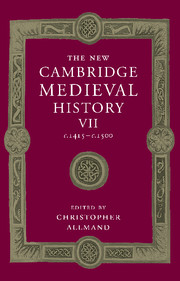Book contents
- Frontmatter
- PART I GOVERNMENT
- PART II ECONOMIC AND SOCIAL DEVELOPMENTS
- PART III SPIRITUAL, CULTURAL AND ARTISTIC LIFE
- PART IV THE DEVELOPMENT OF EUROPEAN STATES
- 17 Germany and the Empire
- 18 Hus, the Hussites and Bohemia
- 19 France
- 20 Burgundy
- 21 England
- 22 The Celtic world
- 23 Italy
- (a) The Northern Italian States
- (b) The Papal States and the Kingdom of Naples
- 24 The Iberian peninsula
- 25 The Swiss Confederation
- 26 The States of Scandinavia, c. 1390– c. 1536
- 27 Hungary: Crown and Estates
- 28 The Kingdom of Poland and the Grand Duchy of Lithuania, 1370–1506
- 29 Russia
- 30 Byzantium: The Roman Orthodox World, 1393–1492
- 31 The Latin East
- 32 The Ottoman World
- 33 Conclusion
- Appendix Genealogical Tables
- Primary Sources and Secondary Works Arranged by Chapter
- Index
- Frontispiece
- Plate section
- Map 1 European towns in the late Middle Ages
- Map 2 European commerce and trade
- Map 4 Winds and currents facilitating the discoveries
- Map 5 The universities o f Europe in 1400 and 1500
- Map 6 Germany and the Empire
- Map 20 The Roman Orthodox and Ottoman worlds in the fifteenth century
- References
(b) - The Papal States and the Kingdom of Naples
from 23 - Italy
Published online by Cambridge University Press: 28 March 2008
- Frontmatter
- PART I GOVERNMENT
- PART II ECONOMIC AND SOCIAL DEVELOPMENTS
- PART III SPIRITUAL, CULTURAL AND ARTISTIC LIFE
- PART IV THE DEVELOPMENT OF EUROPEAN STATES
- 17 Germany and the Empire
- 18 Hus, the Hussites and Bohemia
- 19 France
- 20 Burgundy
- 21 England
- 22 The Celtic world
- 23 Italy
- (a) The Northern Italian States
- (b) The Papal States and the Kingdom of Naples
- 24 The Iberian peninsula
- 25 The Swiss Confederation
- 26 The States of Scandinavia, c. 1390– c. 1536
- 27 Hungary: Crown and Estates
- 28 The Kingdom of Poland and the Grand Duchy of Lithuania, 1370–1506
- 29 Russia
- 30 Byzantium: The Roman Orthodox World, 1393–1492
- 31 The Latin East
- 32 The Ottoman World
- 33 Conclusion
- Appendix Genealogical Tables
- Primary Sources and Secondary Works Arranged by Chapter
- Index
- Frontispiece
- Plate section
- Map 1 European towns in the late Middle Ages
- Map 2 European commerce and trade
- Map 4 Winds and currents facilitating the discoveries
- Map 5 The universities o f Europe in 1400 and 1500
- Map 6 Germany and the Empire
- Map 20 The Roman Orthodox and Ottoman worlds in the fifteenth century
- References
Summary
half the territory of Italy, but far less of its wealth and population, lay within the kingdom of Naples and the papal states, for much of the land – mountain, marsh and arid plain – defied habitation or exploitation. Devastated by plague in the fourteenth century, the population touched its nadir around the start of the fifteenth, then began a slow overall growth through the next hundred years despite recurrent epidemics and famine. Six general visitations of plague (1422– 5, 1436– 9, 1447– 51, 1477– 9, 1485– 7, 1493) and a five-year cycle of crop failure inflicted appalling casualties: Viterbo lost 6,600 of its 10,000 inhabitants at the outset of the century and had not recovered fifty years later; 14,000 are said to have perished in Bologna alone in 1447, and 75,000 over the whole kingdom in 1493. Malaria infesting the marshlands created by sedimentation of rivers on the western coasts took its own steady toll of life to add to the victims of occasional disasters such as the earthquake which struck the south in December 1456 killing some 30,000 people.
Relatively few reached an advanced age: Pozzuoli in 1489 had 77.5 per cent of its citizens under thirty years of age, 45.5 per cent under fifteen, figures not without significance for the fiscal health of government. How slowly the population recovered may be measured by the census figures for the kingdom: excluding Naples, they showed only 254,000 hearths in 1500 against 230,000 in 1450. Nor was this increase evenly distributed. Rural depopulation went hand in hand with rapid urban growth, especially in the larger cities. In the province of Rome a quarter of the villages had disappeared between the onset of the Black Death and 1416, most of them for good. Great landowners everywhere seized the opportunity to occupy abandoned farmland which became incorporated in their latifundia – large, backward, thinly peopled estates devoted overwhelmingly to a pastoral economy which produced wool for export and meat for the cities.
Keywords
- Type
- Chapter
- Information
- The New Cambridge Medieval History , pp. 571 - 587Publisher: Cambridge University PressPrint publication year: 1998
References
- 1
- Cited by

